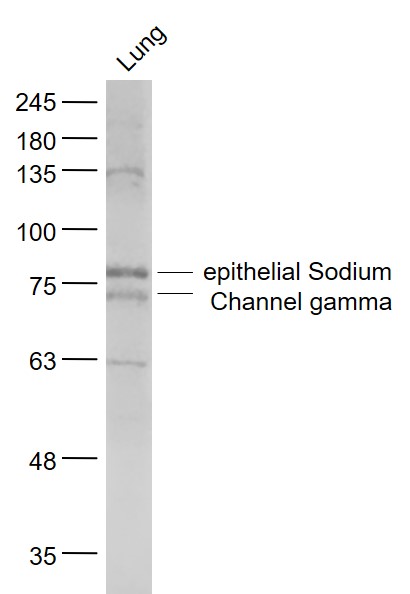
Rabbit Anti-epithelial Sodium Channel gamma antibody
Amiloride sensitive epithelial sodium channel gamma subunit; Amiloride sensitive sodium channel subunit gamma; ENaC gamma subunit; ENaCg; ENaCgamma; Epithelial Na(+) channel subunit gamma; Epithelial Na+ channel subunit gamma; Gamma ENaC; Gamma NaCH; Nonv
View History [Clear]
Details
Product Name epithelial Sodium Channel gamma Chinese Name 上皮钠离子Channel proteinγ/γENaC抗体 Alias Amiloride sensitive epithelial sodium channel gamma subunit; Amiloride sensitive sodium channel subunit gamma; ENaC gamma subunit; ENaCg; ENaCgamma; Epithelial Na(+) channel subunit gamma; Epithelial Na+ channel subunit gamma; Gamma ENaC; Gamma NaCH; Nonvoltage gated sodium channel 1 subunit gamma; PHA 1; PHA1; SCNEG; SCNN 1G; SCNN1G; Sodium channel nonvoltage gated 1 gamma; SCNNG_HUMAN. Research Area Tumour immunology Neurobiology Signal transduction Channel protein The cell membrane受体 Immunogen Species Rabbit Clonality Polyclonal React Species Mouse, (predicted: Human, Rat, Dog, Rabbit, ) Applications WB=1:500-2000 ELISA=1:5000-10000 IHC-P=1:100-500 (Paraffin sections need antigen repair)
not yet tested in other applications.
optimal dilutions/concentrations should be determined by the end user.Theoretical molecular weight 71kDa Cellular localization The cell membrane Form Liquid Concentration 1mg/ml immunogen KLH conjugated synthetic peptide derived from human epithelial Sodium Channel gamma: 188-290/649 <Extracellular> Lsotype IgG Purification affinity purified by Protein A Buffer Solution 0.01M TBS(pH7.4) with 1% BSA, 0.03% Proclin300 and 50% Glycerol. Storage Shipped at 4℃. Store at -20 °C for one year. Avoid repeated freeze/thaw cycles. Attention This product as supplied is intended for research use only, not for use in human, therapeutic or diagnostic applications. PubMed PubMed Product Detail Epithelial sodium channels are amiloride-sensitive members of the Degenerin/epithelial sodium channel (Deg/ENaC) superfamily of ion channels. Members of this superfamily of ion channels share organizational similarity in that they all possess two short intracellular amino and carboxyl termini, two short membrane spanning segments, and a large extracellular loop with a conserved cysteine-rich region. There are three homologous isoforms of the ENaC (alpha, beta, and gamma) protein. ENaC in the kidney, lung, and colon plays an essential role in trans-epithelial sodium and fluid balance. ENaC also mediates aldosterone-dependent sodium reabsorption in the distal nephron of the kidney, thus regulating blood pressure. ENaC is thought to be regulated, in part, through association with the cystic fibrosis transmembrane conductance regulator (CFTR) chloride ion channel. Gain-of-function mutations in beta- or gamma-ENaC can cause severe arterial hypertension (Liddel’s syndrome) and loss-of-function mutations in alpha- or beta-ENaC causes pseudohypoaldosteronism (PHA-1).
Function:
Sodium permeable non-voltage-sensitive ion channel inhibited by the diuretic amiloride. Mediates the electrodiffusion of the luminal sodium (and water, which follows osmotically) through the apical membrane of epithelial cells. Controls the reabsorption of sodium in kidney, colon, lung and sweat glands. Also plays a role in taste perception.
Subunit:
Probable heterotrimer containing one alpha, one beta and one gamma subunit. A delta subunit can replace the alpha subunit. Interacts with the WW domains of NEDD4, NEDD4L, WWP1 and WWP2.
Subcellular Location:
Apical cell membrane; Multi-pass membrane protein. Note=Apical membrane of epithelial cells.
Post-translational modifications:
Phosphorylated on serine and threonine residues.
Ubiquitinated; this targets individual subunits for endocytosis and proteasome-mediated degradation.
DISEASE:
Defects in SCNN1G are a cause of Liddle syndrome (LIDDS) [MIM:177200]. It is an autosomal dominant disorder characterized by pseudoaldosteronism and hypertension associated with hypokalemic alkalosis. The disease is caused by constitutive activation of the renal epithelial sodium channel.
Defects in SCNN1G are the cause of bronchiectasis with or without elevated sweat chloride type 3 (BESC3) [MIM:613071]. A debilitating respiratory disease characterized by chronic, abnormal dilatation of the bronchi and other cystic fibrosis-like symptoms in the absence of known causes of bronchiectasis (cystic fibrosis, autoimmune diseases, ciliary dyskinesia, common variable immunodeficiency, foreign body obstruction). Clinical features include sub-normal lung function, sinopulmonary infections, chronic productive cough, excessive sputum production, and elevated sweat chloride in some cases.
Similarity:
Belongs to the amiloride-sensitive sodium channel (TC 1.A.6) family. SCNN1G subfamily.
SWISS:
P51170
Gene ID:
6340
Database links:Entrez Gene: 6340 Human
Entrez Gene: 20278 Mouse
Omim: 600761 Human
SwissProt: P51170 Human
SwissProt: Q9WU39 Mouse
SwissProt: Q28738 Rabbit
Unigene: 371727 Human
Unigene: 35247 Mouse
Unigene: 10360 Rat
Product Picture
References (0)
No References
Bought notes(bought amounts latest0)
No one bought this product
User Comment(Total0User Comment Num)
- No comment



 +86 571 56623320
+86 571 56623320
 +86 18668110335
+86 18668110335

